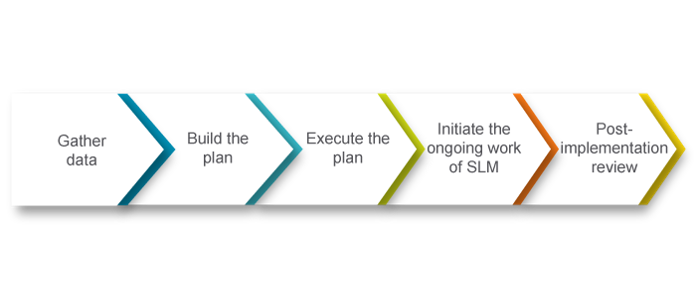
Service Level Management is the process that is responsible for negotiating Service Level Agreements and ensuring that they are met. IT is one of the 5 components of the ITIL service delivery area. The processes under SLM provide a framework upon which the services are defined, the service levels are agreed upon, service level agreements (SLAs) and Operational Level Agreements (OLAs) are developed in order to fulfill the contracts, and the costs of the services which are under development.
What is Service Level Management?
The main purpose of service level management is to make sure that every IT service presently being provided and planned for the future is delivered as per the previously agreed upon service level targets.
The main objective of service level management is:
The objectives of service level management are to do the following:
- Define, document, agree, monitor, measure, report, and review the level of IT services that are being provided.
- Make sure that the targets which are set are precise and assessable.
- Monitor the levels of customer satisfaction and improve them.
- Improve the relationship between the customers and the business and increase the level of communication.
- Ensure that the expectations of the level of service which will be delivered are clear and unambiguous
- Make sure that there is a constant improvement in all the service levels even after the targets have been met.
Scope of Service Level Management
The following come under the scope of service level management:
- Service level management represents the service provider to the business and the business to the service provider.
- SLM manages the expectations and perceptions that are held by the businesses, customers, and users and makes sure that the services are provided according to those expectations.
- Its emphasis ranges from the services being presently delivered, the services which are being newly designed or modified to producing and agreeing on the service level requirements for these services.
Value of Service Level Management
Service Level Management implementation provides several benefits. Some of them are:
- It allows for a better understanding between the IT department and business units.
- SLM provides a consistent channel of communication and a trusted relationship between the customers and the business representatives.
- It provides businesses with the agreed service targets and the necessary information to guarantee that the targets will be met.
- It clearly demarcates the roles and responsibilities.
- It provides the flexibility that businesses require in order to react in time to different market conditions.
- It clearly defines service levels and thus helps to create accurate infrastructure sizing.
- It helps to evade and lessen the costs which come attached with superfluous or inadequate capacity.
Principles & Basic Concepts of Service Level Management
Service Level Requirements (SLRs)
The Service Level Requirements (SLRs) define the requirements of a customer for an IT service based on business objectives, and they are used to negotiate service level agreements (SLAs).
Service Level Agreements (SLAs)
A Service Level Agreement (SLA) is an agreement between an IT service provider and a customer.
This agreement describes the IT service, documents the service level targets, and specifies the responsibilities of the IT service provider and the customer. A single agreement can cover multiple IT services or customers.
Service Level Agreement Frameworks
The options available while designing the SLA frameworks are:
- Service-based SLAs: They describe a specific IT service that has to be delivered.
- Customer-based SLAs: They describe all IT services which are delivered to a specific customer.
- Multi-level SLAs: The service level agreements at each level are inherited by those at the next. This makes the SLAs easier to work with as it helps with the ongoing maintenance.
Service Level Management Process
The process activities of Service Level Management include:
- Designing the framework of the Service Level Agreement (SLA)
- To find out, document, and agree on the business requirements for new services and produce service level requirements.
- Translating the business requirements into IT requirements.
- To negotiate, document, agree, monitor, and report on the service level agreements for operational services.
- Conducting a gap analysis between the requirements for the business and the services which are available.
- Performing service reviews and prompt improvements to an overall service improvement program.
- Measure the performance of the service level agreement, report the results and make the necessary adjustments to maintain the required level of customer satisfaction.
Implementation Procedure for Service Level Management
The following steps are taken to implement Service Level Management in ITIL:
Gather Data
The data is gathered through the following processes:
- Assessing the current state, inventory tools, and the software being used presently.
- Collecting budget details related to capacity management
- Performing a gap analysis to reveal the areas of improvement
- Developing a project plan
Build the Plan
The implementation plan should do the following:
- Establish the people, processes and tools required
- Summarize the costs which will be incurred to sustain the new organization and prepare a budget.
- Find out the ideal position for the service level manager in the organization.
- Describe the exact workflow and allow enough time for training the people who will do the work
Execute the Plan
The steps involved in the execution of the plan are:
- Allocate the proper staff
- Document and publish the process
- Obtain and implement the tools
- Built a service catalog
- Identify, develop, negotiate and implement SLAs
- Identify the necessary services which are not being provided
- Define the metrics to quantify success
- Build materials for training and execute the training plan.
- Implement the procedures for reporting the processes and procedures
Initiate the Ongoing Work of SLM
The reporting process should include abilities to alert the SLM team automatically when:
- Services are in danger of missing performance targets because of sudden bottlenecks.
- Services are in danger of missing performance targets because of sudden surges in demand
- The trends show that performance is approaching the agreed-upon limits
Post-implementation Review
The lessons which are learned should be well-documented so that any changes which should be made to the process to facilitate future process migrations can be identified.
Risk & Challenges of Service Level Management
The challenges faced in service level management are:
- Identifying the right people and involving them in the customer base while drafting and agreeing to the service level agreements.
- An appropriate service should be selected by the organization if they are new to service level management.
- The SLA needs to be agreed upon by both sides.
The risks involved in service level management are:
- An absence of accurate input or commitment from the business.
- A lack of the necessary tools and resources is required to execute the process.
- The business and customer measurements which are extremely tough to measure and improve are not recorded.
Conclusion
Service Level Management thus makes sure that the targets which are set are precise and assessable, improving the levels of customer satisfaction and the relationship between the customers and the business. It ensures that there is a constant improvement in all the service levels even after the targets have been met. Give yourself a chance to grow in your Service Management career with the ITIL 4 Foundation certification training, and gain useful skills and best practices.
Know more about Service Management best practices through Invensis Learning’s IT Service Management certification training on ITIL 4 Training and Certification, SIAM Foundation, SIAM professional, VeriSM, etc.
















